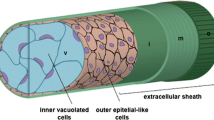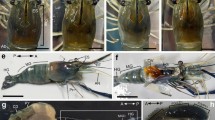Abstract
Acetylcholine is an excitatory neurotransmitter important for oxygen sensing in mammals. A cholinergic mechanism in the fish gill has been implicated in the hyperventilatory response to acute hypoxia; however, the identity and distribution of acetylcholine-containing cells in the gills is poorly defined. We test the hypothesis that cholinergic cells are present in the gill filament epithelium in zebrafish (Danio rerio), a model vertebrate for which oxygen chemoreceptors are well characterized, and that these cells would receive nervous innervation. Using immunohistochemistry and confocal microscopy, we observed 10.2 ± 0.6 cells immunoreactive for the vesicular acetylcholine transporter (VAChT) on the efferent aspect of each gill filament, where a high density of serotonergic oxygen-sensitive neuroepithelial cells (NECs) were located. VAChT-positive cells of the efferent epithelium were positioned within 10 μm of NECs. On the afferent aspect of the gill filaments, VAChT-positive cells were greater in number (30.8 ± 3.1 per filament). On the efferent and afferent filament aspects, VAChT-positive cells did not contain serotonin, but did express choline acetyltransferase (ChAT), the enzyme that synthesizes ACh, and were often closely apposed to nerve fibers labeled with the neuronal marker, zn-12. We conclude that cholinergic cells in the zebrafish gills were present in the primary epithelium of gill filaments, and formed contacts with nerve fibers. These studies provide morphological evidence for the presence of a cholinergic system in the zebrafish gill. Such a pathway may contribute to the reflex hyperventilatory response during hypoxia.








Similar content being viewed by others
References
Abdallah SJ, Jonz MG, Perry SF (2015) Extracellular H+ induces Ca2+ signals in respiratory chemoreceptors of zebrafish. Pflugers Arch 467:399–413
Bailly Y, Dunel-Erb S (1986) The sphincter of the efferent filament artery in teleost gills: I. structure, and parasympathetic innervation. J Morphol 187:219–237
Bailly Y, Dunel-Erb S, Laurent P (1992) The neuroepithelial cells of the fish gill filament: indolamine-immunocytochemistry and innervation. Anat Rec 233:143–161
Booth JH (1978) The distribution of blood flow in the gills of fish: application of a new technique to rainbow trout (Salmo gairdneri). J Exp Biol 73:119–129
Booth JH (1979) The effects of oxygen supply, epinephrine, and acetylcholine on the distribution of blood flow in trout gills. J Exp Biol 83:31–39
Buckler KJ (2007) TASK-like potassium channels and oxygen sensing in the carotid body. Respir Physiol Neurobiol 157:55–64
Burleson ML, Milsom WK (1995a) Cardio-ventilatory control in rainbow trout: I. Pharmacology of branchial, oxygen-sensitive chemoreceptors. Respir Physiol 100:231–238
Burleson ML, Milsom WK (1995b) Cardio-ventilatory control in rainbow trout: II. Reflex effects of exogenous neurochemicals. Respir Physiol 101:289–299
Clemente D, Porteros A, Weruaga E, Alonso JR, Arenzana FJ, Aijón J, Arévalo R (2004) Cholinergic elements in the zebrafish central nervous system: histochemical and immunohistochemical analysis. J Comp Neurol 474:75–107
Coolidge EH, Ciuhandu CS, Milsom WK (2008) A comparative analysis of putative oxygen-sensing cells in the fish gill. J Exp Biol 211:1231–1242
Cutz E, Pan J, Yeger H, Domnik NJ, Fisher JT (2013) Recent advances and contraversies on the role of pulmonary neuroepithelial bodies as airway sensors. Semin Cell Dev Biol 24:40–50
Dasso LL, Buckler KJ, Baughan-Jones RD (1997) Muscarinic and nicotinic receptors raise intracellular Ca2+ levels in rat carotid body type I cells. J Physiol 498:327–338
Dunel-Erb S, Bailly Y, Laurent P (1982) Neuroepithelial cells in fish gill primary lamellae. J Appl Physiol Respir Environ Exerc Physiol 53:1342–1353
Fu XW, Nurse CA, Wong V, Cutz E (2002) Hypoxia-induced secretion of serotonin from intact pulmonary neuroepithelial bodies in neonatal rabbit. J Physiol 539:503–510
Houser A, McNair C, Piccinini R, Luxhoj A, Bell WE, Turner JE (2011) Effects of estrogen on the neuromuscular system in the embryonic zebrafish (Danio rerio). Brain Res 1381:106–116
Iturriaga R, Alcayaga J (2004) Neurotransmission in the carotid body: transmitters and modulators between glomus cells and petrosal ganglion nerve terminals. Brain Res Brain Res Rev 47:46–53
Jonz MG (2014) Oxygen sensing. In: Evans DH, Claiborne JB, Currie S (eds) The physiology of fishes, 4th edn. CRC, Boca Raton, pp 149–175
Jonz MG, Nurse CA (2003) Neuroepithelial cells and associated innervation of the zebrafish gill: a confocal immunofluorescence study. J Comp Neurol 461:1–17
Jonz MG, Nurse CA (2005) Development of oxygen sensing in the gills of zebrafish. J Exp Biol 208:1537–1549
Jonz MG, Zaccone G (2009) Nervous control of the gills. Acta Histochem 111:207–216
Jonz MG, Fearon IM, Nurse CA (2004) Neuroepithelial oxygen chemoreceptors of the zebrafish gill. J Physiol 560:737–752
Jonz MG, Zachar PC, Da Fonte DF, Mierzwa AS (2015) Peripheral chemoreceptors in fish: a brief history and a look ahead. Comp Biochem Physiol A 186:27–38
Kumar P, Prabhakar NR (2012) Peripheral chemoreceptors: function and plasticity of the carotid body. Compr Physiol 2:141–219
Kusakabe T (2002) Carotid labyrinth of amphibians. Microsc Res Tech 59:207–226
López-Barneo J, López-López JR, Ureña J, González C (1988) Chemotransduction in the carotid body: K+ current modulated by PO2 in type I chemoreceptor cells. Science 241:580–582
Mauceri A, Fasulo S, Minniti F, Lo Cascio P, Maisano M, Zaccone G (2005) Neurochemical features of the innervation of respiratory organs in some air-breathing fishes. Ital J Zool 72:175–181
Milsom WK, Burleson ML (2007) Peripheral arterial chemoreceptors and the evolution of the carotid body. Respir Physiol Neurobiol 157:4–11
Nilsson S (1984) Innervation and pharmacology of the gills. In: Hoar WS, Randall DJ (eds) Fish physiology, vol. XA. Academic, San Diego, pp 185–227
Nurse CA (2010) Neurotransmitter and neuromodulatory mechanisms at peripheral arterial chemoreceptors. Exp Physiol 95:657–667
Olsson C (2011) Calbindin immunoreactivity in the enteric nervous system of larval and adult zebrafish (Danio rerio). Cell Tissue Res 3441:31–40
Paulsen UJ, Tiedemann K, Mack AF (2010) Dendritic differentiation in the periphery of the growing zebrafish retina. Exp Eye Res 90:514–520
Peers C, Wyatt CN, Evans AM (2010) Mechanisms for acute oxygen sensing in the carotid body. Respir Physiol Neurobiol 174:292–298
Perry SF, Jonz MG, Gilmour KM (2009) Oxygen sensing and the hypoxic ventilatory response. In: Richards J, Farrell A, Brauner C (eds) Hypoxia. Academic, Waltham, pp 193–253
Porteus CS, Brink DL, Milsom WK (2012) Neurotransmitter profiles in fish gills: putative gill oxygen chemoreceptors. Respir Physiol Neurobiol 184:316–325
Porteus CS, Brink DL, Coolidge EH, Fong AY, Milsom WK (2013) Distribution of acetylcholine and catecholamines in fish gills and their potential roles in the hypoxic ventilatory response. Acta Histochem 115:158–169
Prado MA, Reis RA, Prado VF, de Mello MC, Gomez MV, de Mello FG (2002) Regulation of acetylcholine synthesis and storage. Neurochem Int 41:291–299
Qin Z, Lewis JE, Perry SF (2010) Zebrafish (Danio rerio) gill neuroepithelial cells are sensitive chemoreceptors for environmental CO2. J Physiol 588:861–872
Regan KS, Jonz MG, Wright PA (2011) Neuroepithelial cells and the hypoxia emersion response in the amphibious fish Kryptolebias marmoratus. J Exp Biol 214:2560–2568
Roghani A, Feldman J, Kohan SA, Shirzadi A, Gundersen CB, Brecha N, Edwards RH (1994) Molecular cloning of a putative vesicular transporter for acetylcholine. Proc Natl Acad Sci U S A 91:10620–10624
Saltys HA, Jonz MG, Nurse CA (2006) Comparative study of gill neuroepithelial cells and their innervation in teleosts and Xenopus tadpoles. Cell Tissue Res 323:1–10
Shakarchi K, Zachar PC, Jonz MG (2013) Serotonergic and cholinergic elements elements of the hypoxic ventilatory response in devloping zebrafish. J Exp Biol 216:869–880
Shirahata M, Balbir A, Otsubo T, Fitzgerald RS (2007) Role of acetylcholine in neurotransmission of the carotid body. Respir Physiol Neurobiol 157:93–105
Stoyek MR, Croll RP, Smith FM (2015) Intrinsic and extrinsic innervation of the heart in zebrafish (Danio rerio). J Comp Neurol 523:1683–1700
Sundin L, Nilsson S (1997) Neurochemical mechanisms behind gill microcirculatory responses to hypoxia in trout: in vivo microscopy study. Am J Physiol 41:R576–R585
Sundin L, Nilsson S (2002) Branchial innervation. J Exp Zool 293:232–248
Trevarrow B, Marks DL, Kimmel CB (1990) Organization of hindbrain segments in the zebrafish embryo. Neuron 4:669–679
Wyatt CN, Peers C (1993) Nicotinic acetylcholine receptors in isolated type I cells of the neonatal rat carotid body. Neuroscience 54:275–281
Zaccone G, Ainis L, Mauceri A, Lo Cascio P, Lo Giudice F, Fasulo S (2003) NANC nerves in the respiratory air sac and branchial vasculature of the Indian catfish, Heteropneustes fossilis. Acta Histochem 105:151–163
Zachar PC, Jonz MG (2012) Confocal imaging of Merkel-like basal cells in the taste buds of zebrafish. Acta Histochem 114:101–115
Zhang L, Nurse CA, Jonz MG, Wood CM (2011) Ammonia sensing by neuroepithelial cells and ventilatory responses to ammonia in rainbow trout. J Exp Biol 214:2678–2689
Acknowledgments
This research was supported by the Natural Sciences and Engineering Research Council of Canada (grant number 342303), the Canadian Foundation for Innovation, and the Ontario Research Fund (grant number 16589).
Author information
Authors and Affiliations
Corresponding author
Rights and permissions
About this article
Cite this article
Zachar, P.C., Pan, W. & Jonz, M.G. Distribution and morphology of cholinergic cells in the branchial epithelium of zebrafish (Danio rerio). Cell Tissue Res 367, 169–179 (2017). https://doi.org/10.1007/s00441-016-2531-6
Received:
Accepted:
Published:
Issue Date:
DOI: https://doi.org/10.1007/s00441-016-2531-6




